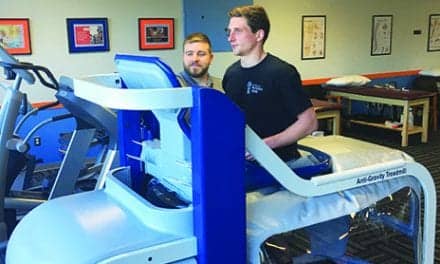A news release from the National Institutes of Health (NIH) reports that a novel therapy encompassing electrical stimulation of the spine has allowed four paraplegic patients to voluntarily move their previously paralyzed muscles. In the release, the NIH indicates that the participants, each of whom had been paralyzed for more than 2 years, were able to voluntarily flex their toes, ankles, and knees while the stimulator was active. Movements were also enhanced gradually when blended with physical rehabilitation.
According to the release, a key finding of the study suggests two of the patients who benefitted from the spinal stimulation had complete motor and sensory paralysis.
Watch a video of the novel therapy in action here
The release states that the study builds on a pilot trial facilitated in 2009 designed to determine whether spinal stimulation, integrated with daily training on a treadmill, could assist patients with paralysis in regaining some ability to move. Trial participant Rob Summers, a patient paralyzed below his chest, had a 16-electrode array implanted in his spinal cord. While undergoing daily training in which he was suspended in a harness over a treadmill as researchers supported his legs, the array delivered electrical pulses to his spinal cord just below his injury.
The results of the trial indicate that while his stimulator was active, Summers was gradually able to bear his own weight and could eventually stand without assistance for up to 4 minutes. Seven months after the trial, Summers reportedly found that he had also regained some voluntary control of his legs. Summers also observed improvement in other impairments caused by his injury in the absence of stimulation, the release says, including blood pressure control, bladder control, and body temperature regulation.
In the current follow-up study, Claudi Angeli, PhD, assistant professor, University of Louisville’s Kentucky Spinal Cord Injury Research Center, and colleagues state that three additional patients with paralysis have recovered voluntary muscle control after electrical stimulation of the spine. The three study participants included two individuals with complete motor and sensory paralysis, and one with complete motor paralysis but some ability to experience sensation below his injury. The release notes that within a few days following the start of stimulation, all three patients regained some voluntary control of previously paralyzed muscles.
Their report appears in the April 8 online issue of Brain.
In the release, researchers articulate their amazement in the speed that the first participant implanted after Summers recovered voluntary movement. The participant was unable to move or experience any sensation below his injury and was initially intended to serve as the baseline patient.
Susan Harkema, PhD, director of rehabilitation research, the Kentucky Spinal Cord Injury Research Center, University of Louisville, explains that it was not just the voluntary movement that astounded researchers, but the speed at which it presented. “We saw it in the first week of stimulation. We then saw it in the next two patients as well,” Harkema says.
This speed is something the researchers emphasize, as this may indicate evidence that there may be dormant connections that exist in patients with complete motor paralysis.
To this end, the researcher responsible for developing the novel approach to rehabilitation, V. Reggie Edgerton, PhD, a UCLA distinguished professor of integrative biology and physiology, states, “Rather than there being a complete separation of the upper and lower regions relative to the injury, it’s possible that there is some contact, but that these connections are not functional.” The spinal stimulation, Edgerton adds, may be “reawakening” these connections.
The current study also aimed to assess the ability of each patient to modulate his movements in response to auditory and visual cues. All participants were able to synchronize leg, ankle, and toe movements in unison with the rise and fall of a wave displayed on a computer screen, the release reports. Three out of the four participants were also able to change the force at which they flexed their leg, depending upon the intensity of three different auditory cues, the release says.
The researchers say the same tests were also administered after several months of spinal stimulation applied in conjunction with locomotor training. The patients also carried out a home-based training comprised of hour-long stimulation while practicing intentional movements lying down. At the training’s end, some of the participants were able to execute voluntary movements with greater force and reduced stimulation, the release states, while others experienced enhanced movement accuracy. Harkema adds that it is unclear whether the improvement stems from the training or the cumulative effects of stimulation over time. Testing this will be key in their next study.
In the release, Susan Howley, executive vice president for research at the Christopher & Dana Reeve Foundation, Short Hills, NJ, notes that the current study shows that the researchers’ previous findings reported in The Lancet were not an anomaly. “The implications of this study for the entire field are quite profound, and we can now envision a day where epidural stimulation might be part of a cocktail of therapies used to treat paralysis.”
Additionally, Edgerton and collaborators Joel Burdick and Y.C. Tai, professors of mechanical and electrical engineering and bioengineering at Caltech, are working to develop a new high-density, 27-electrode array in rates in an effort to determine whether it can offer finer, more robust control of locomotion.
Edgerton points out that the technology used in the study participants was initially designed for suppression of back pain, “and our animal experiments have told us that we can do much better. For a given type of movement, we want to be able to select exactly where and how to stimulate the spinal cord. We just don’t have that flexibility in the current technology.”
Harkema adds that while further work is required, the results of the new study offer enough evidence to challenge currently held beliefs about the prognosis of patients with severe spinal cord injuries.
[Photo Credit: University of Louisville]
[Source: National Institutes of Health]





